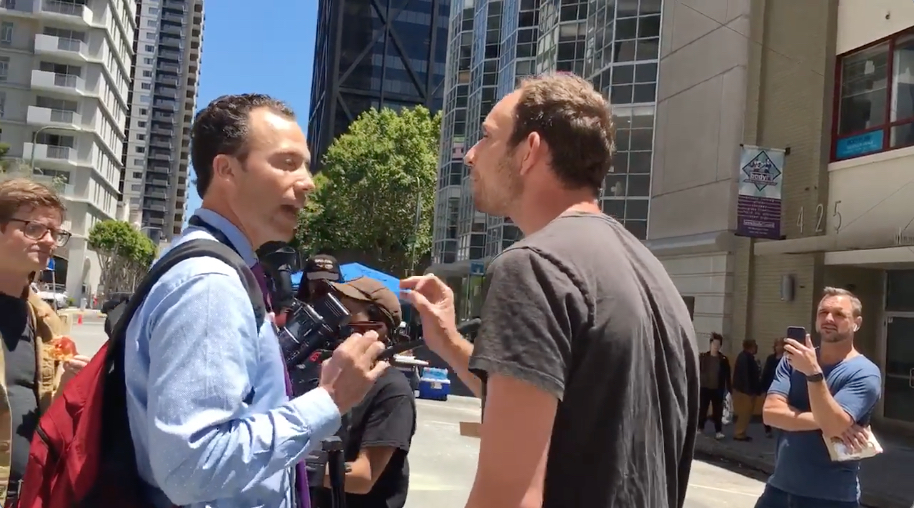Free speech. The First Amendment. Public street. These phrases are familiar to all TV news crews. We base our careers on them. They allow us to do our jobs.
But just because we have a legal right to do something, doesn’t mean everyone else understands or agrees with that right. Sometimes people like us showing up, sometimes they don’t. Lately it seems the reception we get from the people who don’t want us around is getting more coarse, downright angry. And it goes beyond “Leave!” and “Get that camera out of here!”
“I’m seeing more and more people, especially in the Antifa movement, who think that it’s perfectly fine to tell other people they don’t have the same rights they’re trying to express,” said Mickey Osterreicher, the general counsel for the National Press Photographers Association.
Moreover, protesters may physically attempt to prevent journalists from covering events. An internet search for protesters blocking television cameras in 2018 yields 13,500,000 results, including tweets from journalists like these:
[expander_maker id=”1″ more=”Read more” less=”Read less”]
“People find our names, they find our faces, they stalk us…” said the man holding a black sheet over a Spectrum recorder. pic.twitter.com/m5PLWh6Mm4
— The Daily Tar Heel (@dailytarheel) August 25, 2018
“Fu** you, snitch ass news bitch. Fu** you”. #Charlotsville pic.twitter.com/JPl3480FUG
— Cal Perry (@CalNBC) August 12, 2018
This is the moment protestors and members of Antifa tried to stop us from filming and then cut our audio cable. pic.twitter.com/yJc4Z77nvS
— DeJuan Hoggard (@DeJuanABC11) August 12, 2018
Protestors didn’t want to be filmed and cut my photographer’s audio cable cord. pic.twitter.com/GBLryCjWZs
— DeJuan Hoggard (@DeJuanABC11) August 12, 2018
Figuring out how to handle these situations can be tricky, especially for inexperienced news crews or journalists working alone. During this confrontation with Abolish ICE protestors in San Francisco in July, I considered the following.
Safety
Our job is to report, not get hurt. The scene here was a wide public street, in the daylight, with lots of passersby. That environment is ideal for an MMJ to make a stand.
However, after about four minutes, I got the sense more of the crowd was getting angry and decided walking away was more prudent.
When is the right time to stand down? Each news crew needs to decide for itself. Experience can help make the call, considering location, the size of the crowd, the level of tension and whether there are other news crews or police around.
Newsworthiness
Is the subject matter essential to the story? In this case, the fact protestors, who were exercising their First Amendment rights on a public street, wanted to deny those same rights to a reporter helped the viewers better understand who was organizing the event.
News crews should never provoke a confrontation just because they can. That’s not our job. At the same time, our job is to inform the public and that sometimes means standing up for ourselves in uncomfortable situations.
The law
All reporters and videographers should be familiar with where they can and cannot work and what they can and cannot shoot. Having the law on your side is a great opening argument to make with people who want to shut down journalism.
“The easiest rule of thumb to remember is that if you have a legal right to be present — standing in a traditional public forum such as a sidewalk or a park or private property with the permission of the owner — then you may photograph or record whatever you are able to see in plain sight,” Osterreicher said. “It does not make a difference in the analysis whether you have a camera in your hand or you are just standing there and observing.”
Law enforcement often has a better understanding of what the law allows journalists to do than protesters, Osterreicher said. For a better understanding of what legal limitations journalists do face, check out the Know Your Rights section of the NPPA’s Advocacy Resources.
Plan ahead
If a less-than-welcoming reception is predictable, get newsroom managers involved ahead of time.
In the San Francisco market, there have been so many attacks on news crews, several stations now require an armed guard to accompany reporters and videographers to known hot spots. At the least, when the newsroom is aware of what could happen beforehand, producers can establish a backup plan if the news crew has to abandon the story or live shot for safety reasons.
In the end, avoiding confrontation altogether is the best option. No one likes it. But in today’s environment, journalists don’t always get to choose. Sometimes the confrontation comes to us.
We should be prepared for it and know how to get the job done.
Simon Perez is an associate professor of broadcast and digital journalism at Syracuse University’s S.I. Newhouse School of Public Communications. In the summers of 2012, 2014, 2015, 2016, 2017 and 2018 he returned to his former job as a reporter for KPIX TV in San Francisco. He has chronicled his newsroom experiences and the lessons he hopes to bring back to the classroom at http://www.simonperez.com/blog.
[/expander_maker]







